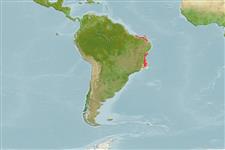Common names from other countries
Classification / Names / Names
Nama-nama umum | Sinonim (persamaan) | Catalog of Fishes (gen., sp.) | ITIS | CoL | WoRMS
Environment: milieu / climate zone / depth range / distribution range
Ekologi
; kisaran kedalaman 0 - 30 m (Ref. 848). Tropical; 1°S - 25°S, 45°W - 37°W (Ref. 848)
Southwest Atlantic: Tamandare and Abrolhos Islands, Brazil.
Length at first maturity / Size / Weight / umur
Maturity: Lm ? range ? - ? cm
Formation: with tubular corallites, often over 1 m across. Individual or small group of corallites usually not connected, i.e., have dead basal connections, and are easily broken and scattered. Corallites: rounded, in varied shapes averaging 15 to 20 mm diameter. Septa: rounded, bead-like dentations only in living colonies. Color: mostly bluish-gray (Ref. 848).
Occurs in shallow turbid reef environments (Ref. 848).
Life cycle and mating behavior
Kematangan | Reproduksi, perkembang biakan | Pemijahan | telur-telur | Fecundity | Larva
Members of the class Anthozoa are either gonochoric or hermaphroditic. Mature gametes are shed into the coelenteron and spawned through the mouth. Life cycle: The zygote develops into a planktonic planula larva. Metamorphosis begins with early morphogenesis of tentacles, septa and pharynx before larval settlement on the aboral end.
rujukan utama
Acuan | Koordinator | mitra
Veron, J.E.N. 2000. (Ref. 848)
Status IUCN Red List (Ref. 130435)
status CITES (Ref. 108899)
Not Evaluated
penggunaan manusia
| FishSource |
Alat, peralatan
informasi lanjut
Umur / SaizPertumbuhanpanjang-beratpanjang-panjangMorfologiLarvaKelimpahan
Sumber internet
Estimates based on models
Preferred temperature
(Ref.
115969): 25.9 - 27.6, mean 27 (based on 87 cells).
kategori harga
Unknown.
